Museums and Filming Locations in the Bridgerton Series
Bridgerton premiered on Netflix in December 2019, breaking viewership records. The show set in Regency London was filmed at various locations...
Jimena Escoto 22 July 2024
The Accountant is a 2016 action thriller starring Ben Affleck, Anna Kendrick, and J. K. Simmons, and was directed by Gavin O’Connor. It centers on the character of Christian Wolff, a man who has high-functioning autism. He also happens to be a deadly assassin as well as a brilliant accountant. Sounds like fun right? It certainly is! Wolff accepts payment in goods as well as cash, which sometimes extends to fine art. Paintings in the movie The Accountant include Woman with a Parasol and Small Child on a Sunlit Hillside by Pierre-Auguste Renoir, Free Form by Jackson Pollock and A Friend in Need by Cassius Coolidge. All three paintings have enormous real-world fiscal value, but within the context of the film their immense value is also symbolic.

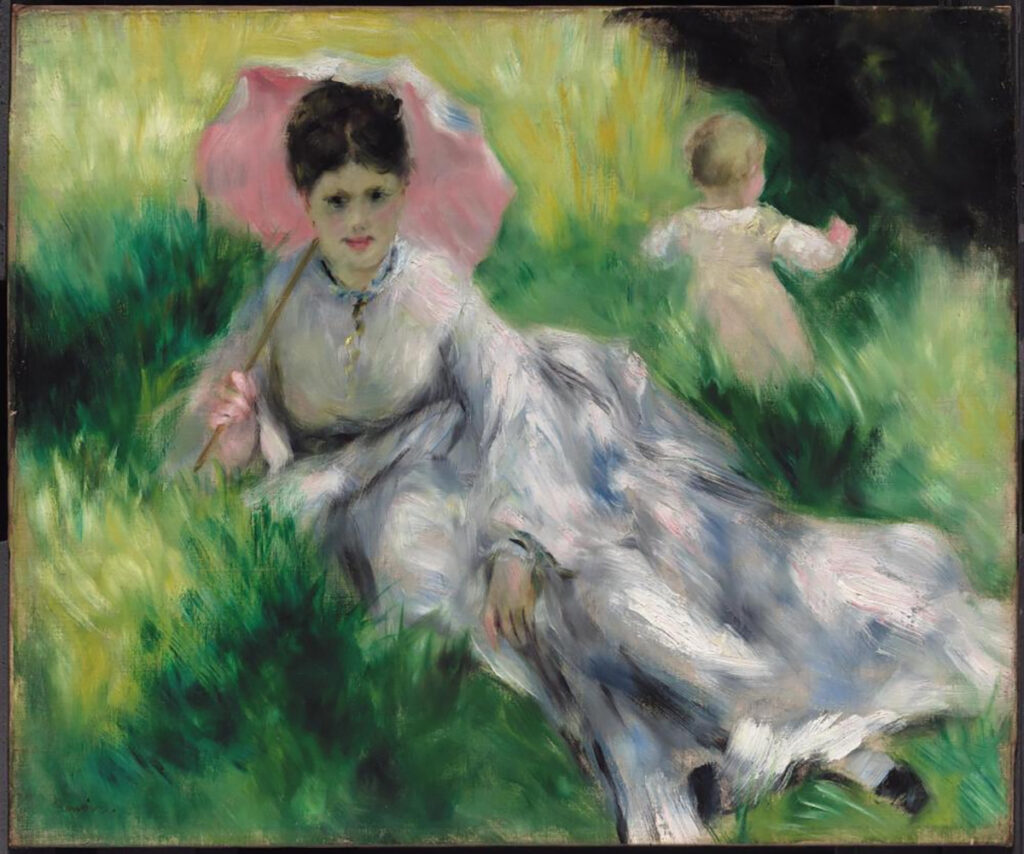
Pierre-Auguste Renoir (1841–1919) was a founding member of the Impressionist movement in France during the latter half of the 19th century. Impressionists sought to find ways of expressing their subjects through quick, intuitive painting techniques and loose compositions. They moved away from the tight, classical studio-finished conventions of the day and experimented with new techniques. Often they would paint in situ in order to capture the fleeting qualities of the light and movement that they saw. They sometimes finished the work in one sitting, leaving it with an unpolished look. This was radical and against all the traditional rules of art!
Renoir liked to try to capture everyday life, with emphasis on the people living it. Often the setting was a stage for this more important concern. His paintings are like soft-focus photography: they are sensual, soft and flattering. His paintings of social gatherings depict the variety of people and activities that can occur in just a few moments in time. Renoir wanted to capture that particular kind of bustling energy.
Although he started out as a pure Impressionist, he gravitated away from this style and we see in his later works a more thoughtful, precise, and unhurried execution rather than a spontaneous and dynamic one. That said, in the painting featured here, completed before his change of approach, we can see that his style is still more controlled than that of his Impressionist contemporaries.
Some would say that Renoir had not quite understood the Zeitgeist of being an Impressionist (despite being a founding member). Some also say that it shows a lack of talent, seeing him instead as an artist in the shadow of Claude Monet. I don’t think that this is true. Renoir’s style and approach were different from those of Monet, so why should his paintings be the same? Human interaction is key for Renoir. His desire to place it at the center of his work narrowed his focus and therefore demanded a firmer technique.
Worth less than the Pollock but more than the Coolidge, of the paintings in The Accountant, the Renoir is worth somewhere in the region of $70 million. To understand its value as part of the plot a little background is necessary.
Wolff was the reason for the family’s abandonment by their mother. She was unable to accept his autism, finding that his behavior was too challenging. It fell to the father to bring up a young family. He taught both his sons and Christian in particular, how to navigate through a life that would inevitably be more difficult. In this regard he was successful. In the film, we see that Wolff has specific coping mechanisms that enable him to engage successfully with the real world. This is how he survives whatever life may throw at him.
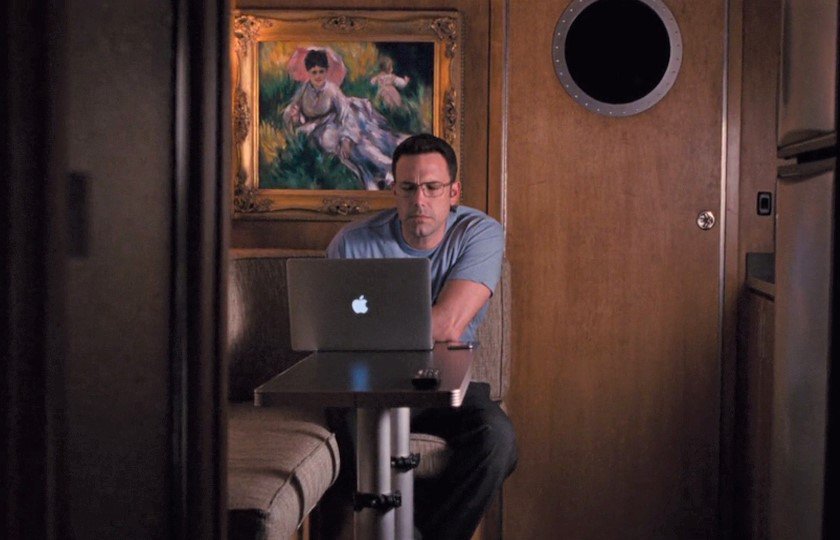


So why choose Renoir? This painting depicts a scene of a mother and child, bathed in the sunshine of summer. Why not choose a painting of a male figure instead? Especially if it’s going to hang just outside his weapons room? Its incongruity is important. Throughout the film, Wolff is at odds with his surroundings. Details like this painting cast against the brutality of a room full of guns serve to highlight this further.
The mother in the painting is the epitome of the feminine ideal of the time. She is soft, relaxed, and happy. She poses on a hillside in a gentle palette of pale colors: whites, blues, grays, and pinks. Everything about her is womanly, delicate, graceful, and demure. Her child on the other hand is wandering off behind her, as toddlers do. Is she aware of this? Her eyes look away rather than out to meet the artist’s gaze. Is this a moment of daydreaming on a hot day, or does her subtle smile suggest that she is listening intently for the sound of her adventuring child?
Wolff’s mother was not ideal, at least not for him, and we see a child wandering away from its mother in this painting. We know that it would be lost if left unattended. Wolff, however, was not lost. He had a strong father and a brother who loved him. In this respect the Renoir is again incongruous: in reality, it was the mother who wandered away and was lost. Wolff in turn became a paragon of composure.
Wolff might see the Renoir only as a painting, or maybe as something more. I thought that it might signify acceptance of his mother’s actions. There is a sense that the woman in the picture might represent the contentment that she later found. From this standpoint it makes sense that he is able to sell the Renoir, dropping the price in order to do so. This is a closed chapter in his life. He doesn’t need to worry about it.
The Renoir therefore might be a comment on Wolff’s ability to rationalize strong and deep emotions. Often it is thought, mistakenly, that people with autism don’t have emotions. This is simply not true. Autistic people most certainly do feel, possibly even more deeply. It is their ability to process and manage how they feel that is more challenging. Where most of us understand our emotions, somebody with autism might need more help to do so.
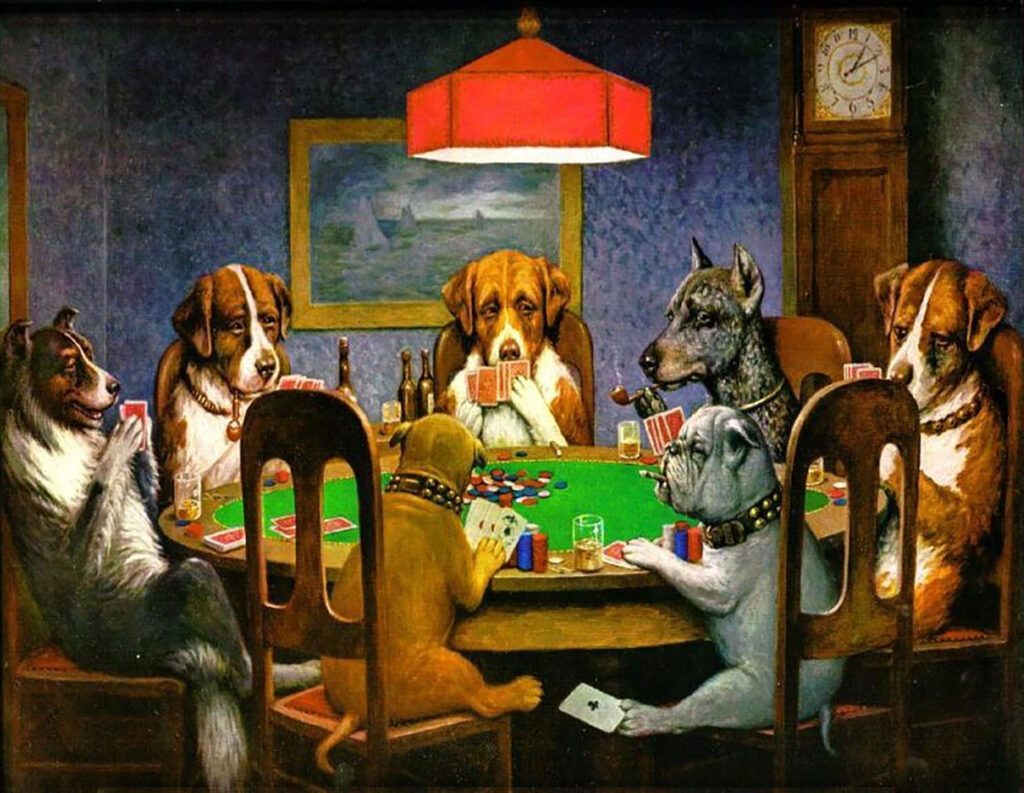


Anthropomorphized animals are nothing new (think Alice in Wonderland’s Cheshire Cat or the Caterpillar). Endowing animals with human qualities never fails to charm, even if sometimes it’s really weird. We take great delight in seeing ourselves laid bare in this way. It’s close enough to strike a chord but removed enough to be amusing. We don’t end up taking ourselves – or the art – too seriously. We’re comfortably challenged because we can have a laugh about it.
It is indeed the humorous aspect of these paintings that makes them so popular. They are attractive because they are funny, which seems to override any denunciation that might be levied at them by the “serious” critic. This particular painting – A Friend in Need – is only one of 16 from a series called Dogs Playing Poker. It was created after Coolidge signed up to work for the advertising agency Brown & Bigelow in 1903. The series was produced as part of an advertising campaign for cigars, and calendars containing them found themselves disseminated across America by the thousands.
Described as kitsch, is it wrong to appreciate these works as art? Not at all! Very often something becomes more popular because it has a greater universal appeal. In this case, a parody of human behavior makes us laugh. A Friend in Need is also highly accessible: there are no esoteric clues or symbols. There is no mystery and it is down-to-earth. Its humor is capable of reaching everybody, with no exclusions. A cynic at this point would say that as an advertisement it has, therefore, done its job rather well.
Wolff refers to A Friend in Need during a conversation with Dana Cummings (played by Anna Kendrick) in which she confesses that she wanted to go to art college. Her father persuaded her to become an accountant instead. She implies that the Dogs Playing Poker series is the kind of art that her father would like. The inference is that it is mainstream, popular, and not really “proper” art.



Wolff states “I like Dogs Playing Poker, because dogs would never bet on things, and so it’s incongruous. I like incongruity”. This incongruity really appeals to his nature as someone who lives his life by logical assessment rather than by taking chances. He sees the irony in the idea put forward by the painting. A Friend in Need presents dogs with human attributes – does Wolff see himself as a human with canine ones?
Although A Friend in Need is probably worth a five or even six-figure sum, it is the least valuable of the paintings featured in The Accountant. It also never appears as an original, but only as a copy. Its incongruity remains important as a plot device: a copy of it is used to disguise the very much more valuable Jackson Pollock that Wolff gives to Dana at the end.
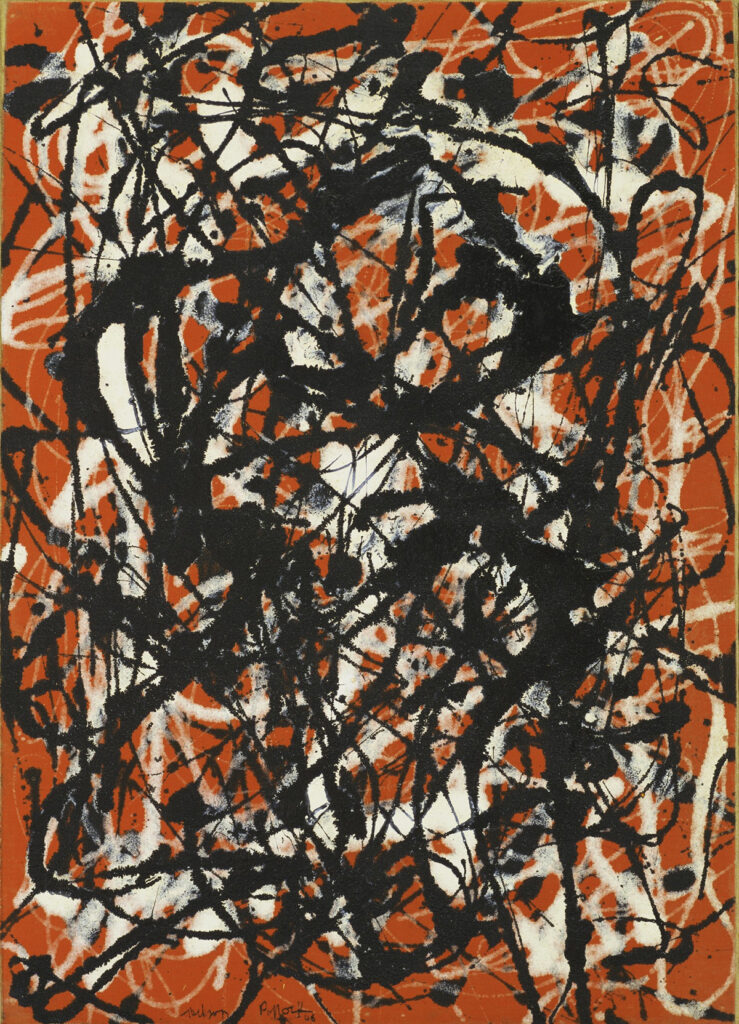


Europe before World War II was the center for art, but after the war, this center shifted to America where different types of art began to evolve during the following decades. This was in part due to the exodus from Europe of many prominent artists, but new and radical forms of art had already begun to emerge in Europe during the decades prior to World War II, for example, Constructivism, Dadaism, and Surrealism, not to mention developments in film and photography, so pushing the boundaries of art was not surprising. There was a need to challenge the formal rules and regulations concerning what defined art.
Jackson Pollock wanted to push the conventional boundaries of painting, especially easel painting. He implied that shifts in artistic style are a direct result of a desire to find answers to artistic problems and that new techniques are a product of this process. He was driven to find a new form and explore ways of leaving the old behind and embracing the new. The idea of the canvas as a self-limiting object was a prominent theme for Pollock: this is the easel painting from which he sought emancipation. He used a flat canvas plane in the creation of his most famous artworks. Rather than placing them upright, he laid them on the floor, and he did not stretch or prime them. Pollock was able to approach the canvas from any direction, and therefore exceed the limits of the upright easel format.
Pollock’s method of dripping, pouring, and splattering paint rather than using brushstrokes or a palette knife pulled his form still further away from tradition. Using these methods he applied paint to form many layers of a densely-woven web that seem to exceed the confines of the picture plane. Free Form shows an action that extends beyond the edges: it is almost as though the detail that we can see is just one small part of something much greater, possibly infinite. Among the splatters and drips we find a sense of order: there has been no specific provision of line or shape, no figuration, no relative planes except that of the work to the wall upon which it hangs, yet there is a sense of something other than chaos.
Pollock’s drip paintings lie somewhere between existing as objects and existing beyond being objects. By reason of logic they are still shackled by the dimensions of the canvas itself, but they come about as close as possible to transcending it. The key to this is that as observers we are capable of looking beyond the confines of borders, and we can erase physical edges to continue the patterns for ourselves. I think this is why it’s possible to become so entangled in a Pollock: there is endless variety, and there are endless possibilities for what might happen in the unseen worlds of our imaginations.
Pollock’s work in terms of both monetary and personal value is worth the most in The Accountant. Thought to be worth somewhere in the region of $140 million, it is also the painting that Wolff won’t sell. We see him lying on the bed in his Airstream early in the movie, staring up at the painting which he has mounted on the ceiling. It has a calming effect on him, making us question what it is that he really sees in it. Perhaps he sees method in the convoluted trails of layered paint?
Wolff operates beyond the usual boundaries in the same way that Pollock’s drip paintings do. There is therefore a deep and special connection between Wolff and this painting. It stands to reason that he sees patterns where others do not and that this might both please and fascinate him. He might also be more than capable of seeing how these patterns would extend beyond the canvas. This would please Pollock! It also makes it hugely significant that he later gives it to Dana, hinting that he feels he has a similar relationship with her.
Paintings in the movie The Accountant have various fun details, a few of which I’d like to mention here. This is by no means an exhaustive list!
Paintings in the movie The Accountant might also include the jigsaw puzzle seen at the beginning (a young Wolff is completing it back-to-front). Technically this is a photograph of course, but it is still a significant visual symbol. It is in fact an image of Cassius Clay/Muhammad Ali. He loses the final piece causing him to fly into a panic. A young girl named Justine finds it and he then completes the puzzle. We see it again at the end of the film, this time the correct way around and framed as a picture on the wall of Justine’s room. It signifies the connection that Wolff and Justine made as children, and indicates their lifelong friendship.
I worked out that if you calculate the gap between the dates of the artworks, you get the following: Renoir (1874) to Coolidge (1903) is 29 years, and Coolidge to Pollock (1946) is 43 years. These are both prime numbers. If you then add 29 and 43 you get 72, which is the number of years between the Renoir and the Pollock! This is possibly coincidental but suits a film about an accountant.
Cassius Marcellus Coolidge (1844-1934) was born only twelve or so years after Lewis Carroll and so was still a very young man when Alice in Wonderland was published in 1865!
It is interesting that Renoir and Coolidge were born within three years of each other (1841 and 1844 respectively) but that their art couldn’t be more different.
The Pollock shown in The Accountant is not the original (although it is for the characters). It is identical but for an eye looking out from near the center: an addition made by the filmmakers.
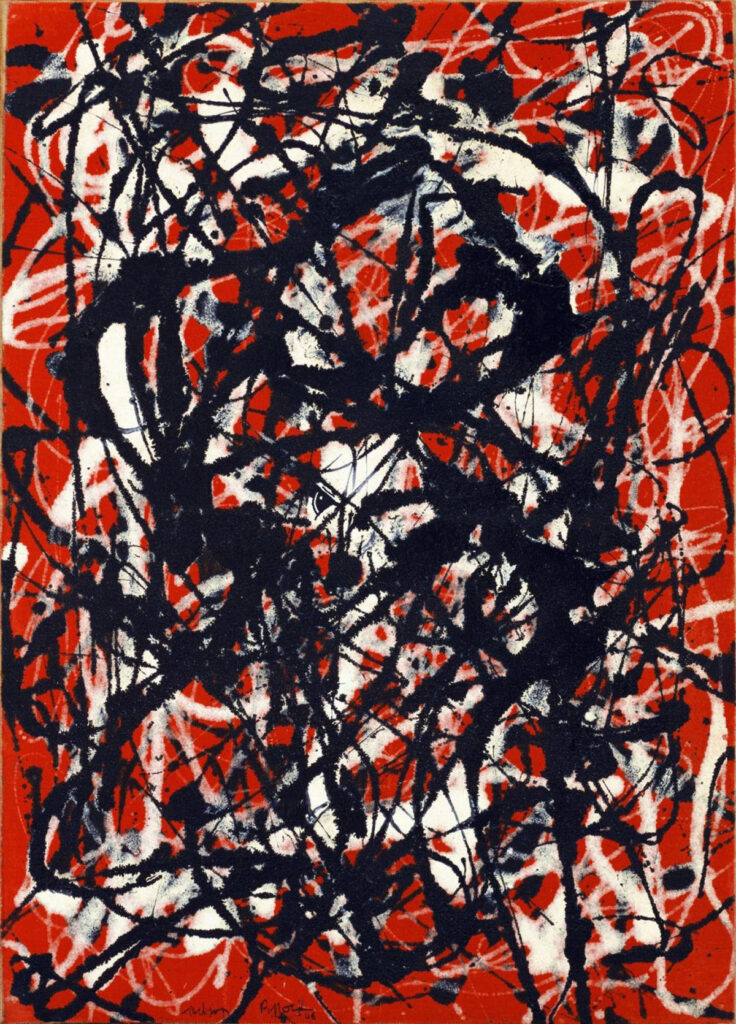


DailyArt Magazine needs your support. Every contribution, however big or small, is very valuable for our future. Thanks to it, we will be able to sustain and grow the Magazine. Thank you for your help!